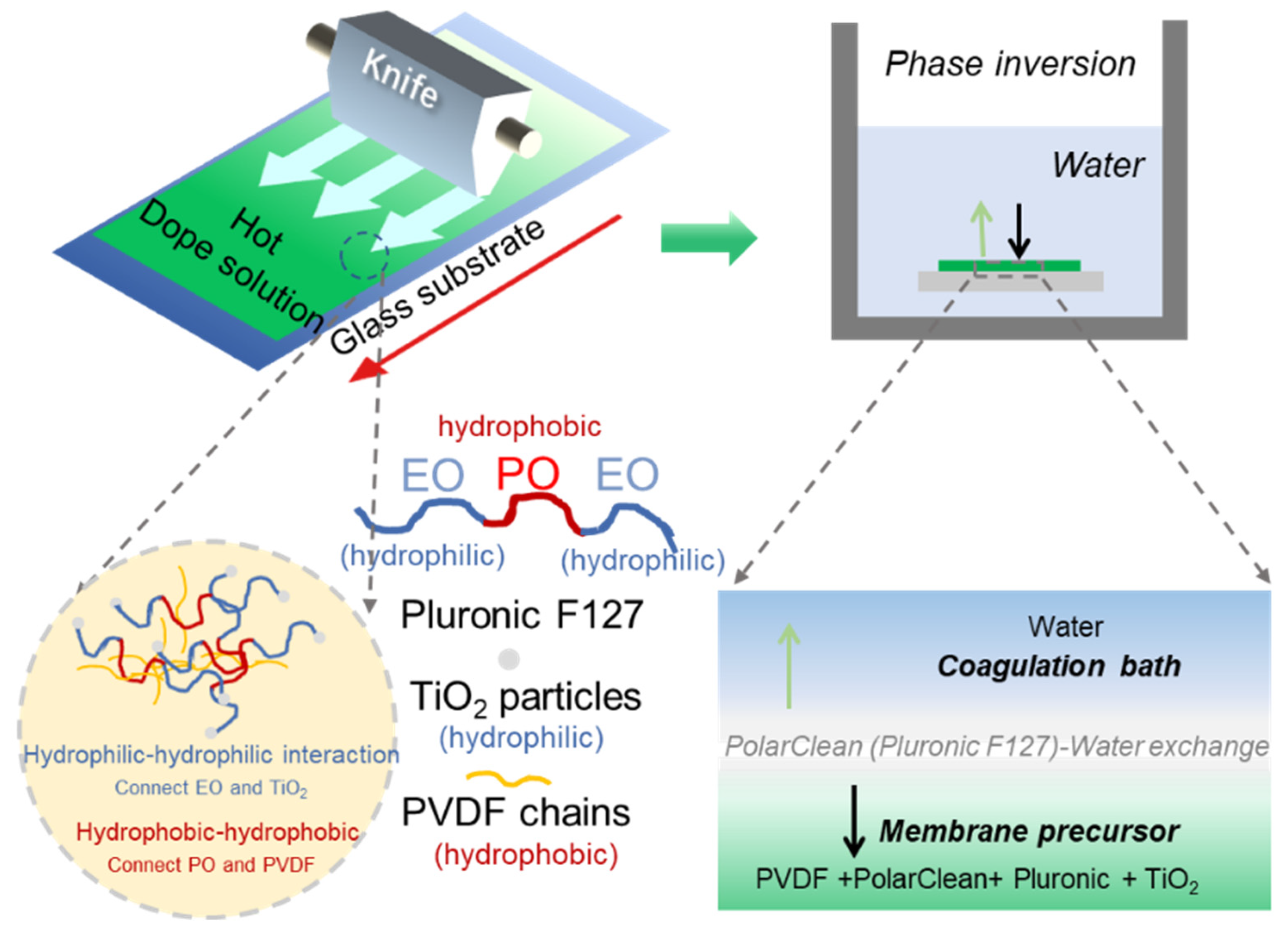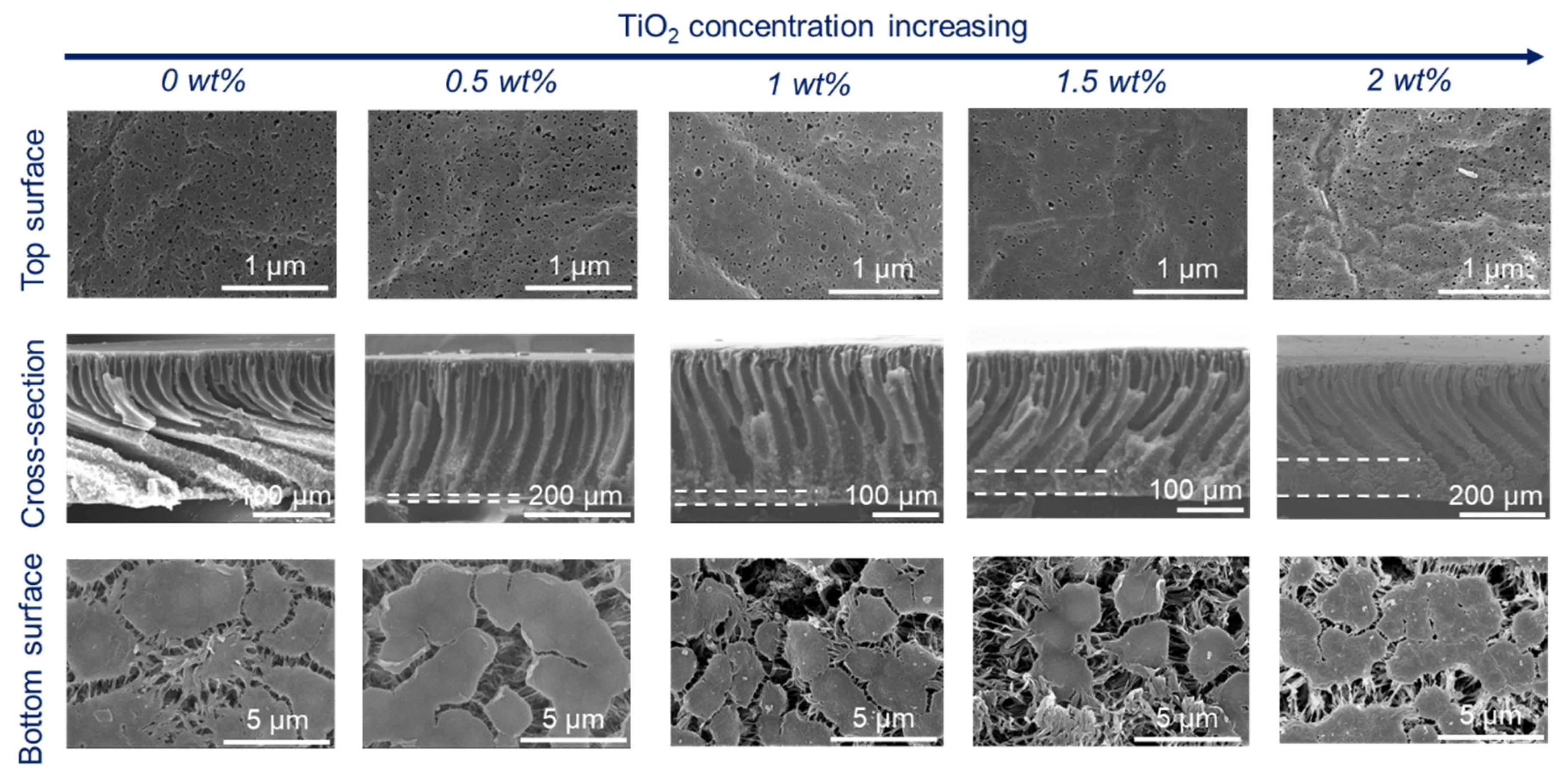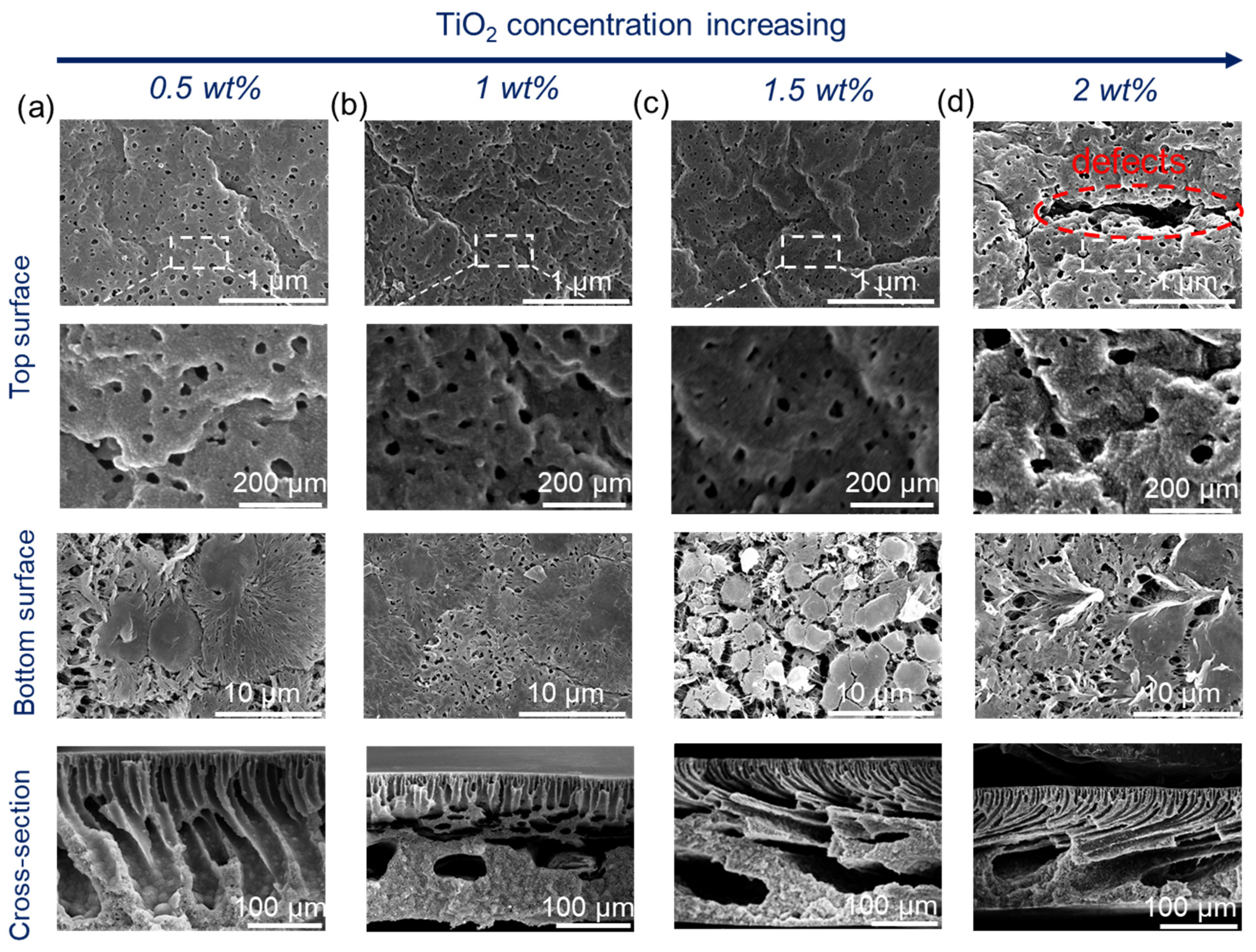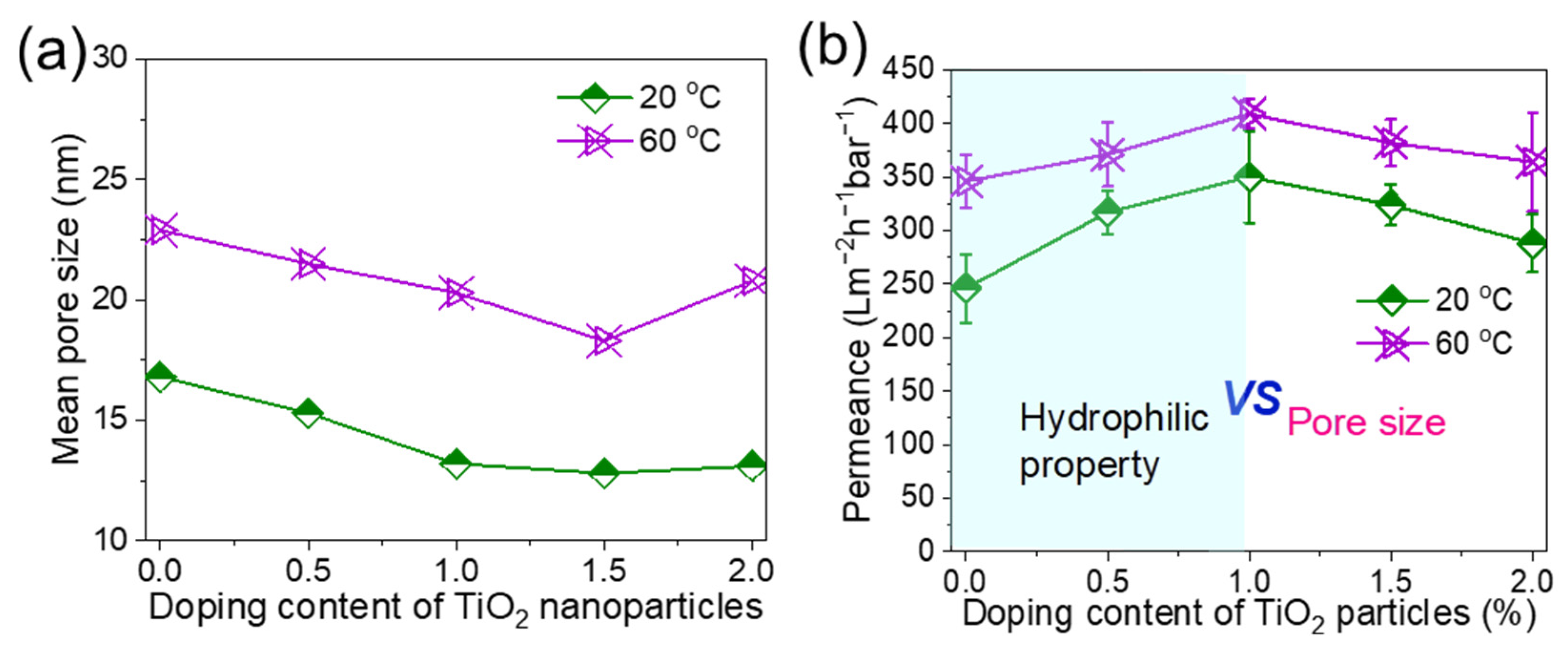Fabrication of Green PVDF/TiO2 Composite Membrane for Water Treatment
Abstract
1. Introduction
2. Experimental
2.1. Materials
2.2. Membrane Fabrication
2.2.1. PolarClean/PVDF Membranes
2.2.2. PolarClean/PVDF/TiO2 Membranes
2.2.3. NMP/PVDF and NMP/PVDF/TiO2 Composite Membranes
2.3. Characterization
3. Results and Discussion
3.1. Effects of TiO2 Content and Coagulation Temperature
3.2. Effect of PVDF Concentration
3.3. Distribution of TiO2 Particles
3.4. Performance Comparison of PVDF/TiO2 Membrane from NMP
3.5. Separation of Particle-Laden Waste Water
4. Conclusions
Author Contributions
Funding
Institutional Review Board Statement
Informed Consent Statement
Data Availability Statement
Conflicts of Interest
References
- Zou, D.; Hu, C.; Drioli, E.; Zhong, Z. Engineering green and high-flux poly(vinylidene fluoride) membranes for membrane distillation via a facile co-casting process. J. Membr. Sci. 2022, 655, 120577. [Google Scholar] [CrossRef]
- Dong, Z.; Longbo, X.; Ping, L.; Kecheng, G.; Hideto, M.; Zhong Zhaoxiang, Z. Fabrication of hydrophobic bi-layer fiber-aligned PVDF/PVDF-PSF membranes using green solvent for membrane distillation. Desalination 2023, 565, 116810. [Google Scholar]
- Tang, Y.; Zhu, J.; Yu, H.; Zhang, F.; Hu, S.; Chen, H.; Zhang, C.; Wu, H.; Yu, L.; Wang, X.; et al. Novel PA/PVDF hollow fiber nanofiltration membrane with high permeability and Ca2+/antibiotics selectivity for drinking water purification. Adv. Membr. 2024, 4, 100102. [Google Scholar] [CrossRef]
- Sriyanti, I.; Almafie, M.R.; Nuha Ap Idjan, M.K.; Dani, R.; Solihah, I.; Syafri, E.; Yulianti; Marlina, L. Electrospun nanofiber membrane of Piper beetle loaded PVDF/PAN for medical mask applications: Psychochemical characteristics, antibacterial and air filter test. Adv. Membr. 2025, 5, 100149. [Google Scholar] [CrossRef]
- Lin, Y.; Xu, Y.; Loh, C.H.; Wang, R. Development of robust fluorinated TiO2/PVDF composite hollow fiber membrane for CO2 capture in gas-liquid membrane contactor. Appl. Surf. Sci. 2018, 436, 670–681. [Google Scholar] [CrossRef]
- Zou, D.; Chen, X.; Drioli, E.; Ke, X.; Qiu, M.; Fan, Y. Facile co-sintering process to fabricate sustainable antifouling silver nanoparticles (AgNPs)-enhanced tight ceramic ultrafiltration membranes for protein separation. J. Membr. Sci. 2020, 593, 117402. [Google Scholar] [CrossRef]
- Qin, L.; Dong, G.; Nie, Y.; Fakhrullin, R.; Zhang, B.; Zhang, Y. Progress in design of halloysite nanotubes-polymer nanocomposite membranes and their applications. Adv. Membr. 2024, 4, 100091. [Google Scholar] [CrossRef]
- Cai, Y.; Wang, Y.; Chen, X.; Qiu, M.; Fan, Y. Modified colloidal sol-gel process for fabrication of titania nanofiltration membranes with organic additives. J. Membr. Sci. 2015, 476, 432–441. [Google Scholar] [CrossRef]
- Venkatesh, K.; Gangasalam, A.; Bose, A.C.; Kumar, P.S.; Kweon, J. Diethylenetriaminepentaacetic acid-functionalized multi-walled carbon nanotubes/titanium oxide-PVDF nanofiber membrane for effective separation of oil/water emulsion. Sep. Purif. Technol. 2021, 257, 117926. [Google Scholar] [CrossRef]
- Zou, D.; Chen, X.; Qiu, M.; Drioli, E.; Fan, Y. Flux-enhanced alpha-alumina tight ultrafiltration membranes for effective treatment of dye/salt wastewater at high temperatures. Sep. Purif. Technol. 2019, 215, 143–154. [Google Scholar] [CrossRef]
- Galiano, F.; Song, X.; Marino, T.; Boerrigter, M.; Saoncella, O.; Simone, S.; Faccini, M.; Chaumette, C.; Drioli, E.; Figoli, A. Novel Photocatalytic PVDF/Nano-TiO2 Hollow Fibers for Environmental Remediation. Polymers 2018, 10, 1134. [Google Scholar] [CrossRef] [PubMed]
- Bian, X.; Shi, L.; Yang, X.; Lu, X. Effect of Nano-TiO2Particles on the Performance of PVDF, PVDF-g-(Maleic anhydride), and PVDF-g-Poly(acryl amide) Membranes. Ind. Eng. Chem. Res. 2011, 50, 12113–12123. [Google Scholar] [CrossRef]
- Ngang, H.P.; Ooi, B.S.; Ahmad, A.L.; Lai, S.O. Preparation of PVDF–TiO2 mixed-matrix membrane and its evaluation on dye adsorption and UV-cleaning properties. Chem. Eng. J. 2012, 197, 359–367. [Google Scholar] [CrossRef]
- Kim, D.; Nunes, S.P. Green solvents for membrane manufacture: Recent trends and perspectives. Curr. Opin. Green Sustain. Chem. 2020, 28, 100427. [Google Scholar] [CrossRef]
- Nunes, S.P.; Culfaz-Emecen, P.Z.; Ramon, G.Z.; Visser, T.; Koops, G.H.; Jin, W.; Ulbricht, M. Thinking the future of membranes: Perspectives for advanced and new membrane materials and manufacturing processes. J. Membr. Sci. 2020, 598, 117761. [Google Scholar] [CrossRef]
- Available online: https://eur-lex.europa.eu/legal-content/EN/TXT/?uri=CELEX%3A32018R0588&qid=1614651789553 (accessed on 1 June 2021).
- Rasool, M.A.; Van Goethem, C.; Vankelecom, I.F.J. Green preparation process using methyl lactate for cellulose-acetate-based nanofiltration membranes. Sep. Purif. Technol. 2020, 232, 115903. [Google Scholar] [CrossRef]
- Rasool, M.A.; Vankelecom, I.F.J. Preparation of full-bio-based nanofiltration membranes. J. Membr. Sci. 2021, 618, 118674. [Google Scholar] [CrossRef]
- Ji, D.; Xiao, C.; Chen, K.; Zhou, F.; Gao, Y.; Zhang, T.; Ling, H. Solvent-free green fabrication of PVDF hollow fiber MF membranes with controlled pore structure via melt-spinning and stretching. J. Membr. Sci. 2021, 621, 118953. [Google Scholar] [CrossRef]
- Randová, A.; Bartovská, L.; Morávek, P.; Matějka, P.; Novotná, M.; Matějková, S.; Drioli, E.; Figoli, A.; Lanč, M.; Friess, K. A fundamental study of the physicochemical properties of Rhodiasolv®Polarclean: A promising alternative to common and hazardous solvents. J. Mol. Liq. 2016, 224, 1163–1171. [Google Scholar] [CrossRef]
- Xie, W.; Li, T.; Tiraferri, A.; Drioli, E.; Figoli, A.; Crittenden, J.C.; Liu, B. Toward the Next Generation of Sustainable Membranes from Green Chemistry Principles. ACS Sustain. Chem. Eng. 2020, 9, 50–75. [Google Scholar] [CrossRef]
- Sun, W.; Xia, L.; Luo, P.; Zou, D. A Novel Delayed Phase Inversion Strategy Enables Green PVDF Membranes for Membrane Distillation. Membranes 2024, 14, 241. [Google Scholar] [CrossRef]
- Xia, L.; Guan, K.; He, S.; Luo, P.; Matsuyama, H.; Zhong, Z.; Zou, D. Engineering high-flux poly (vinylidene fluoride) membranes with symmetric structure for membrane distillation via delayed phase inversion. Sep. Purif. Technol. 2024, 338, 126499. [Google Scholar] [CrossRef]
- Zhang, Q.; Cui, Z.; Li, W. High permeability poly(vinylidene fluoride) ultrafiltration membrane doped with polydopamine modified TiO2 nanoparticles. Chin. J. Chem. Eng. 2020, 28, 3152–3158. [Google Scholar] [CrossRef]
- Méricq, J.P.; Mendret, J.; Brosillon, S.; Faur, C. High performance PVDF-TiO2 membranes for water treatment. Chem. Eng. Sci. 2015, 123, 283–291. [Google Scholar] [CrossRef]
- Yuliwati, E.; Ismail, A.F. Effect of additives concentration on the surface properties and performance of PVDF ultrafiltration membranes for refinery produced wastewater treatment. Desalination 2011, 273, 226–234. [Google Scholar] [CrossRef]
- Song, H.; Shao, J.; He, Y.; Liu, B.; Zhong, X. Natural organic matter removal and flux decline with PEG–TiO2-doped PVDF membranes by integration of ultrafiltration with photocatalysis. J. Membr. Sci. 2012, 405–406, 48–56. [Google Scholar] [CrossRef]
- Loh, C.H.; Wang, R. Effects of Additives and Coagulant Temperature on Fabrication of High Performance PVDF/Pluronic F127 Blend Hollow Fiber Membranes via Nonsolvent Induced Phase Separation. Chin. J. Chem. Eng. 2012, 20, 71–79. [Google Scholar] [CrossRef]
- Kusworo, T.D.; Ariyanti, N.; Utomo, D.P. Effect of nano-TiO2 loading in polysulfone membranes on the removal of pollutant following natural-rubber wastewater treatment. J. Water Process Eng. 2020, 35, 101190. [Google Scholar] [CrossRef]
- Dlamini, D.S.; Mamba, B.B.; Li, J.X. The role of nanoparticles in the performance of nano-enabled composite membranes—A critical scientific perspective. Sci. Total Environ. 2019, 656, 723–731. [Google Scholar] [CrossRef]
- Li, J.F.; Xu, Z.L.; Yang, H.; Yu, L.Y.; Liu, M. Effect of TiO2 nanoparticles on the surface morphology and performance of microporous PES membrane. Appl. Surf. Sci. 2009, 255, 4725–4732. [Google Scholar] [CrossRef]
- Feng, J.H.; Xiong, S.; Wang, Z.G.; Cui, Z.L.; Sun, S.P.; Wang, Y. Atomic layer deposition of metal oxides on carbon nanotube fabrics for robust, hydrophilic ultrafiltration membranes. J. Membr. Sci. 2018, 550, 246–253. [Google Scholar] [CrossRef]
- Ma, W.Z.; Zhang, J.; Van der Bruggen, B.; Wang, X.L. Formation of an Interconnected Lamellar Structure in PVDF Membranes with Nanoparticles Addition via Solid-Liquid Thermally Induced Phase Separation. J. Appl. Polym. Sci. 2013, 127, 2715–2723. [Google Scholar] [CrossRef]
- Vasilescu, M.; Bandula, R. Aggregation of Pluronic F127 and polydimethylsiloxane-graft-polyether block copolymers in water and microstructure of aggregates as evaluated by molecular probe techniques. Rev. Roum. De Chim. 2011, 56, 57. [Google Scholar]
- Zhao, J.; Chong, J.Y.; Shi, L.; Wang, R. Explorations of combined nonsolvent and thermally induced phase separation (N-TIPS) method for fabricating novel PVDF hollow fiber membranes using mixed diluents. J. Membr. Sci. 2019, 572, 210–222. [Google Scholar] [CrossRef]
- Zhao, J.; Chong, J.Y.; Shi, L.; Wang, R. PTFE-assisted immobilization of Pluronic F127 in PVDF hollow fiber membranes with enhanced hydrophilicity through nonsolvent-thermally induced phase separation method. J. Membr. Sci. 2021, 620, 118914. [Google Scholar] [CrossRef]
- Chen, H.; Lin, Q.; Xu, Q.; Yang, Y.; Shao, Z.P.; Wang, Y. Plasma activation and atomic layer deposition of TiO2 on polypropylene membranes for improved performances of lithium-ion batteries. J. Membr. Sci. 2014, 458, 217–224. [Google Scholar] [CrossRef]
- Kang, Y.; Jiao, S.; Wang, B.; Lv, X.; Wang, W.; Yin, W.; Zhang, Z.; Zhang, Q.; Tan, Y.; Pang, G. PVDF-Modified TiO2 Nanowires Membrane with Underliquid Dual Superlyophobic Property for Switchable Separation of Oil-Water Emulsions. ACS Appl. Mater. Interfaces 2020, 12, 40925–40936. [Google Scholar] [CrossRef]
- Ye, L.Q.; Yang, C.J.; Tian, L.H.; Zan, L.; Peng, T.Y. Tunable photocatalytic selectivity of fluoropolymer PVDF modified TiO2. Appl. Surf. Sci. 2011, 257, 8072–8077. [Google Scholar] [CrossRef]
- Oh, S.J.; Kim, N.; Lee, Y.T. Preparation and characterization of PVDF/TiO2 organic–inorganic composite membranes for fouling resistance improvement. J. Membr. Sci. 2009, 345, 13–20. [Google Scholar] [CrossRef]
- Tahiri Alaoui, O.; Nguyen, Q.T.; Mbareck, C.; Rhlalou, T. Elaboration and study of poly(vinylidene fluoride)–anatase TiO2 composite membranes in photocatalytic degradation of dyes. Appl. Catal. A: Gen. 2009, 358, 13–20. [Google Scholar] [CrossRef]
- Bae, T.-H.; Tak, T.-M. Effect of TiO2 nanoparticles on fouling mitigation of ultrafiltration membranes for activated sludge filtration. J. Membr. Sci. 2005, 249, 1–8. [Google Scholar] [CrossRef]
- Damodar, R.A.; You, S.J.; Chou, H.H. Study the self cleaning, antibacterial and photocatalytic properties of TiO2 entrapped PVDF membranes. J. Hazard. Mater. 2009, 172, 1321. [Google Scholar] [CrossRef] [PubMed]
- Cao, X.; Ma, J.; Shi, X.; Ren, Z. Effect of TiO2 nanoparticle size on the performance of PVDF membrane. Appl. Surf. Sci. 2006, 253, 2003–2010. [Google Scholar] [CrossRef]
- Yu, L.-Y.; Shen, H.-M.; Xu, Z.-L. PVDF-TiO2 composite hollow fiber ultrafiltration membranes prepared by TiO2 sol-gel method and blending method. J. Appl. Polym. Sci. 2009, 113, 1763–1772. [Google Scholar] [CrossRef]
- Farahani, M.H.D.A.; Vatanpour, V. A comprehensive study on the performance and antifouling enhancement of the PVDF mixed matrix membranes by embedding different nanoparticulates: Clay, functionalized carbon nanotube, SiO2 and TiO2. Sep. Purif. Technol. 2018, 197, 372–381. [Google Scholar] [CrossRef]
- Zeng, G.Y.; He, Y.; Yu, Z.X.; Zhan, Y.Q.; Ma, L.; Zhang, L. Preparation and characterization of a novel PVDF ultrafiltration membrane by blending with TiO2-HNTs nanocomposites. Appl. Surf. Sci. 2016, 371, 624–632. [Google Scholar] [CrossRef]











| Polymer Content (%) | TiO2 Doping Content (%) | Tensile Strength (MPa) | Elongation at Break (%) | Porosity (%) | Mean Pore Size (nm) | PWP (Lm−2h−1bar−1) |
|---|---|---|---|---|---|---|
| 10 | 0 | 0.93 ± 0.16 | 77.49 ± 10.2 | 90.92 | 30.3 | 1025 ± 120 |
| 10 | 0.5 | 1.12 ± 0.10 | 108.7 ± 25.2 | 91.35 | 27.2 | 1100 ± 98 |
| 10 | 1 | 1.32 ± 0.13 | 118.3 ± 18.0 | 91.20 | 25.6 | 1150 ± 170 |
| 20 | 0 | 1.99 ± 0.08 | 115 ± 20.5 | 79.14 | 10.2 | 95 ± 10 |
| 20 | 0.5 | 2.15 ± 0.12 | 126 ± 5.9 | 79.10 | 6.3 | 105 ± 22 |
| 20 | 1 | 2.28 ± 0.20 | 130 ± 17.6 | 79.03 | 6.0 | 108 ± 20 |
| PVDF (wt%) | Solvent | Additives 1 | TiO2/PVDF (wt%) | CA (°) | Pore Size (nm) | PWP (Lm−2h−1bar−1) | Ref. |
|---|---|---|---|---|---|---|---|
| 10 | NMP | - | 0 | 89 | 550 | 770 | [43] |
| - | 10–40 | 82–88 | 380–740 | 1430–480 | |||
| 12 | NMP | - | 0 | 80 | N/A | 70 | [25] |
| - | 25 | 64 | N/A | 150 | |||
| 12 | NMP | - | 0 | 73 | 200 | 330 | [40] |
| - | 17 | 68 | 120 | 310 | |||
| 12 | DMAc | PEG | 0 | 78 | N/A | 300 | [27] |
| 2 | 74 | N/A | 290 | ||||
| 15 | DMF | - | 0 | 78 | 43 | N/A | [41] |
| - | 50 | 81 | 26–90 | N/A | |||
| 15 | NMP | - | 0 | 87 | N/A | 303 | [42] |
| - | 30 | 81 | N/A | 331 | |||
| 16 | DMF | - | 0 | 78 | 50.6 | 88.2 | [44] |
| - | 76 | 47.3 | 111.7 | ||||
| 18 | DMAc | - | 0 | N/A | 50 | 77 | [13] |
| - | 8.3 | N/A | 90 | 393 | |||
| 18 | DMAc/NMP | PVP | 0 | 79 | 61 | 110 | [45] |
| 3–6 | 65–68 | 55–115 | 120–150 | ||||
| 15 | NMP | PVP | 0 | 88 | N/A | 150 | [46] |
| 1.3–27 | 80–70 | N/A | 320–180 | ||||
| 18 | DMAc | PVP | 0 | 77.1 | 20.2 | 67 | [47] |
| 1–3 | 61–53 | 64.6–93.9 | 230–150 | ||||
| 15 | PolarClean | F127 | 0 | 72 | 16.8 | 246 | This work |
| 3.3–13.3 | 60–52 | 15.3–12.2 | 350–288 |
Disclaimer/Publisher’s Note: The statements, opinions and data contained in all publications are solely those of the individual author(s) and contributor(s) and not of MDPI and/or the editor(s). MDPI and/or the editor(s) disclaim responsibility for any injury to people or property resulting from any ideas, methods, instructions or products referred to in the content. |
© 2025 by the authors. Licensee MDPI, Basel, Switzerland. This article is an open access article distributed under the terms and conditions of the Creative Commons Attribution (CC BY) license (https://creativecommons.org/licenses/by/4.0/).
Share and Cite
Lu, S.; Zou, D. Fabrication of Green PVDF/TiO2 Composite Membrane for Water Treatment. Membranes 2025, 15, 218. https://doi.org/10.3390/membranes15070218
Lu S, Zou D. Fabrication of Green PVDF/TiO2 Composite Membrane for Water Treatment. Membranes. 2025; 15(7):218. https://doi.org/10.3390/membranes15070218
Chicago/Turabian StyleLu, Shuhang, and Dong Zou. 2025. "Fabrication of Green PVDF/TiO2 Composite Membrane for Water Treatment" Membranes 15, no. 7: 218. https://doi.org/10.3390/membranes15070218
APA StyleLu, S., & Zou, D. (2025). Fabrication of Green PVDF/TiO2 Composite Membrane for Water Treatment. Membranes, 15(7), 218. https://doi.org/10.3390/membranes15070218






